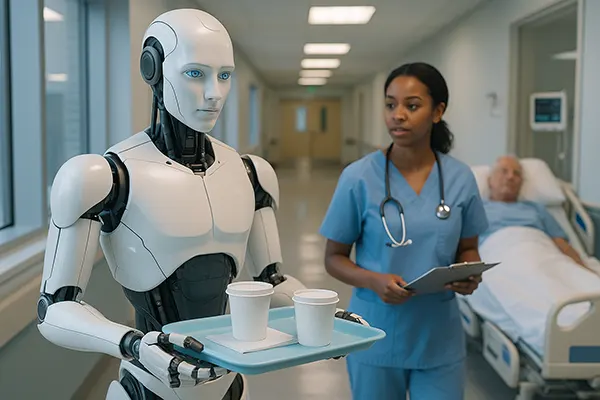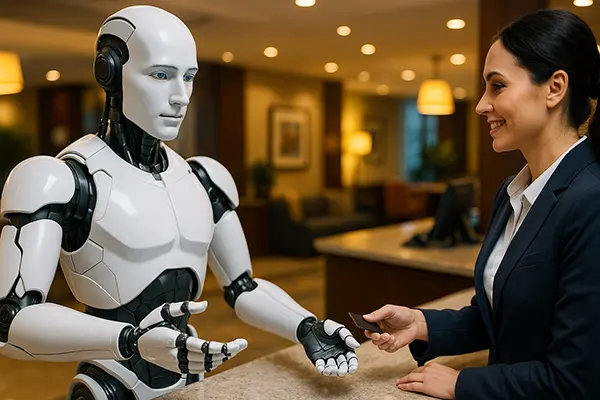In 2025, humanoid robots are no longer a futuristic fantasy. They have become a practical part of everyday operations in hotels, restaurants, hospitals, and customer service centres. Their growing sophistication allows them to perform complex tasks once reserved for humans, while businesses increasingly rely on their efficiency, precision, and reliability. This evolution marks a defining moment in the integration of artificial intelligence and robotics within the service sector.
Technological Advancements Behind Modern Humanoids
The latest generation of humanoid robots is equipped with advanced artificial intelligence systems capable of natural communication and contextual understanding. Unlike early prototypes, these machines can now recognise emotions, interpret gestures, and respond appropriately. This makes them ideal for roles that require social interaction and empathy, such as front-desk assistance or elderly care.
One of the key breakthroughs enabling this progress is the combination of AI with cutting-edge sensors and motion technologies. Humanoids like Tesla’s Optimus, SoftBank’s Pepper, and Engineered Arts’ Ameca use real-time data from cameras, microphones, and tactile sensors to interact with humans in a natural way. Their ability to learn from interactions and adjust behaviour autonomously elevates them beyond simple automation.
Furthermore, continuous improvements in energy efficiency and lightweight materials have allowed humanoids to become more mobile and durable. This makes them suitable for long shifts in environments where constant human availability is not always possible, such as airports or hospitals operating 24/7.
Integration in Everyday Service Operations
In hospitality, humanoid robots have taken over tasks ranging from room delivery to multilingual reception duties. Hotels in Japan, South Korea, and the United Arab Emirates have already reported reductions in operational costs and improved guest satisfaction due to faster service and reduced waiting times. These robots can remember returning guests and personalise their responses, creating a more individualised experience.
In healthcare, humanoids assist nurses with patient monitoring, medicine distribution, and even emotional support. They are equipped with biometric sensors capable of tracking vital signs, ensuring accurate and continuous care. Some hospitals in Europe and Asia have implemented robotic systems to minimise human error and support overstretched medical staff.
Retail environments are also embracing humanoids as customer service assistants. They can answer product-related questions, manage inventories, and guide visitors through stores. In some cases, they are even programmed to handle payments, reducing the need for multiple staff members in peak hours.
Economic and Ethical Implications
The rapid adoption of humanoid robots brings both opportunities and challenges. Economically, they offer efficiency gains and the potential to reduce long-term operational costs. However, they also raise questions about employment displacement in low-skilled positions and the redefinition of human roles in the workplace. Experts believe that while some jobs will disappear, new professions focused on robot management, maintenance, and programming will emerge.
From an ethical standpoint, humanoids provoke debate around responsibility, privacy, and emotional dependency. As they become capable of interpreting and simulating human emotions, the line between machine and human interaction becomes increasingly blurred. Companies implementing these technologies must establish transparent policies to ensure responsible use and data protection.
Another crucial consideration is accessibility. While large corporations can afford humanoid integration, smaller businesses may struggle with the high costs of acquisition and maintenance. Governments and industry organisations are now discussing frameworks to promote fair technological distribution across markets.
Regulation and Standardisation Efforts
To address these concerns, countries such as Japan, Germany, and the United States have introduced new regulatory standards for the use of service robots. These include safety protocols, AI transparency requirements, and ethical guidelines for customer interactions. Such measures aim to prevent misuse and ensure that humanoids operate under clear and accountable conditions.
In Europe, the Artificial Intelligence Act serves as a foundation for monitoring AI-based systems in public and commercial sectors. This framework requires that all humanoid robots used in services adhere to transparency and data protection standards. It also emphasises the need for human oversight in critical decision-making processes.
By 2025, collaboration between governments, robotics manufacturers, and academic institutions is shaping a safer and more ethical integration of humanoids into the workforce. These efforts are not just about technology but about setting a precedent for the responsible evolution of human–machine interaction.

The Future of Human–Robot Collaboration
As humanoids continue to evolve, the concept of cooperation between humans and robots will redefine modern service industries. The goal is no longer replacement but partnership, where robots complement human strengths with precision and endurance. This synergy will enhance productivity while maintaining a human touch where empathy and creativity are irreplaceable.
Education systems worldwide are adapting by introducing robotics and AI courses, preparing future generations for hybrid workplaces. The demand for experts in mechatronics, software engineering, and AI ethics is rapidly increasing. This educational shift ensures that society remains prepared for an economy driven by both human and robotic intelligence.
Ultimately, the success of humanoid robots in the service industry depends on trust. People must feel comfortable interacting with them, understanding their purpose and limitations. The future will belong not to machines or humans alone, but to a cooperative ecosystem where both work together toward greater efficiency, inclusivity, and innovation.
Vision for 2030 and Beyond
By the early 2030s, humanoid robots are expected to become a common presence in daily life. Experts predict their widespread use in public transport systems, healthcare facilities, and home assistance. As the technology becomes more affordable, even small businesses will be able to integrate robots into their operations.
Researchers are also working on improving the emotional intelligence of humanoids to strengthen social bonds between humans and machines. This may lead to entirely new forms of companionship and support services for the elderly and people with disabilities. However, it will remain essential to maintain ethical boundaries and ensure that technology serves humanity rather than replaces it.
As we move further into the age of intelligent automation, humanoid robots will symbolise a new era — one defined by collaboration, ethics, and the relentless pursuit of progress. Their development will continue to challenge our understanding of what it means to work, serve, and coexist in a technologically advanced world.



